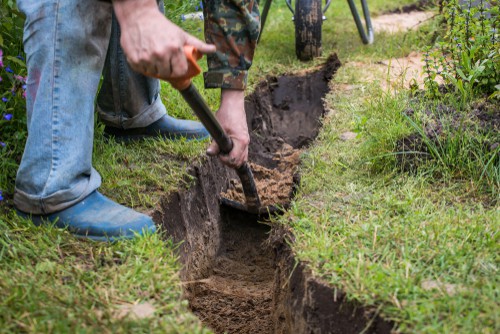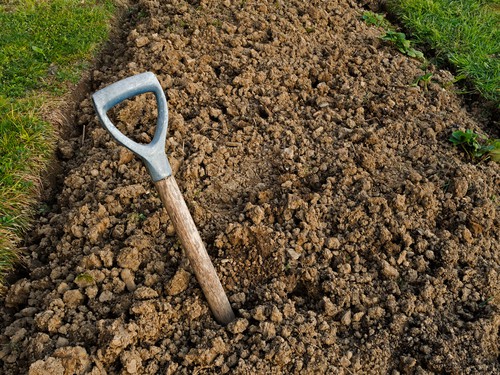Last updated on May 3rd, 2022
Our site is reader supported, this means we may earn a small commission from Amazon and other affiliates when you buy through links on our site.
The climate in the UK brings a lot of inconsistent weather and usually, it brings a lot of rainfall with it. Many gardens in the UK have a big problem with drainage so if your garden is among them, there are steps you can take to greatly improve the soil and help drainage. You could install new drains (which is probably more affordable than you think) and it just takes some hard work, however, improving drainage can simply mean adding organic matter and grit to the soil, particularly if you have clay soil.
Bad drainage becomes particularly problematic in the winter when plants that were newly planted in spring and summer start to succumb to root rot, and lawns turn into bogs which unfortunately encourages moss and algae to grow on your lawn.
There has been a significant increase in the number of homeowners that have done away with large gardens and opted for paving patios and driveways to try and reduce the problem, but this often comes at the expense of gardens borders and lawns. Obviously, a waterlogged set of conditions is not ideal if you’re trying to maintain green grass and other plants.
There are a lot of factors that can contribute to the poor drainage in your garden and the downside is, that bad drainage means you can’t keep your plants growing successfully. So what can you do to fix it?
1. Install drains underneath your lawn and drains around your patio
The first thing you might want to consider is installing a drain. This is a much easier process than you might think, and affordable, however, it does require some back-breaking work if you tackle this yourself. This is for very severe conditions and the drains can even be put underneath lawns where flooding is a problem.
If you want to install a drain to prevent flooding across the whole of your property you will need to dig a series of trenches in your garden and install a perforated land drain and then cover it back up. With this, the water drains through the garden and into that drain pipe and then gets channelled away to another part of your garden.

Most laws in the UK prohibit you from directly channelling the water into a public drain or a sewer system so you’re going to need to find another area in your garden, perhaps an area where waterlogging isn’t a problem, where the water can go and drain away. Ideally, you want it to run into a large ditch that you have filled with gravel and covered up with something like weed control fabric. This is then covered with gravel or soil and then turf (grass), this then acts as a soakaway and does require a proper drain.
You could even use it as a feature and form a dry creek bed (like in the picture below) by digging the channel and covering it with gravel.

If you are going to install a land drainage system you should do it at the end of summer or the beginning of autumn when the ground is dry and it’s best to have some help.
- This Product Adds A Great Value
- Product Is Highly Durable And Very Easy To Use
- This Product Is Manufactured In China
- Country Of Origin: United States
2. Use plants that thrive in wet conditions. These will also soak up the water

Plants can actually be helpful when it comes to improving garden drainage. Large sprawling lawns without a lot of plants leave you much more susceptible to regular flooding. However, if you grow a lot of extra plants that love water they can help prevent that flooding by soaking up some of the water and preventing your garden from turning into a bog.

Plants like Astilbes, Caltha palustris (also known as Marsh Marigold), mint, Hostas, maples, ferns, Lobelia cardinalis, and willow trees are among the many options that you can grow. They thrive in these wet conditions and will help remove the extra moisture.
See our guide on 10 of our favourite plants for wet soil
3. Maintain your lawn by aerating and spiking it

Maintaining your lawn can have a huge impact on improving drainage because many lawns get very compressed when used regularly and the water literally just sits on top during heavy rain. Remove moss and thatch by scarifying your lawn because moss and thatch soak up water and make your lawn like a sponge. It also helps improve your lawn overall.
Learn more about scarifying your lawn in this guide here.
- Fast verticutting without tool blockage
- Fast and complete collection of moss and thatch
- Comes with a 50 Litre collection box, vibration emission value ah: 2.5 m/s², uncertainty K: 1.5 m/s²
- Innovative drum with stainless steel blades and airflow inlets quickly and completely removes the layer of thatch consisting of plant debris moss and weeds from the lawn
Aerating your lawn can also help. This is a process where the lawn is spiked to create holes in the lawn. Aerating can be as simple as forking the lawn or you can use a lawn aerator that removes cores from the lawn for water to enter and get down to the grass roots.
Learn more about how to aerate your lawn in this guide here.
- EASY TO USE - The large 300mm (12") spiked roller quickly and easily aerates your soil. Just push the aerator over your lawn and it will loosen the soil beneath letting oxygen, water and nutrients reach the roots, promoting the growth of your grass
- PROFESSIONAL LAWN CARE - Thirty 45mm (2") spikes provide deep and even aeration, giving you a greener, healthier lawn
- COLOUR - Supplied in Green
- WIDE APPLICATION - Using this Aerator will help your lawn to breathe, loosening soil to ensure the roots get adequate nourishment, water and air, thereby encouraging deep root growth resulting in a greener and more lush lawn
- EASY TO ASSEMBLE - Assembly is needed, but is quick and easy and it comes with a full fixings kit - see a comprehensive instructional video on the Greenkey website
4. Improve the soil by digging in plenty of organic matter and grit
Another option is to tackle the drainage by digging in plenty of organic matter and horticultural grit. This is better suited to gardens that have a small problem, nothing too big.

You can dig in a lot of organic matter. Soil that has more organic content will allow the extra water from the winter rain to drain through. You can always have a compost heap as well so that you have the organic matter on hand every year to add into the soil. It’s also worth digging plenty of grit into the soil because this is said to aid drainage. This is a great solution for those who have clay soil in their garden.
Learn more about improving clay soil in this guide here.
5. Managing the water runoff
By incorporating some slopes or angles into your garden, maybe adding multiple layers and levels to the vertical structure, you can better manage the surface water as it runs off your property. There are very easy ways to manage this surface water so that the rain doesn’t just flood the same spot over and over.

This can be costly depending on your circumstances and it’s always best to speak with an expert landscaper and hire an excavator to help you sculpt the contours that you need. This is also a great opportunity to design your garden so that it efficiently moves water into the plant beds you have for your moisture-loving plants or into a pond that you have made on your property. This method is best combined with adding drains at the end of driveways and patios that can divert water away from lawns and garden borders.
- Drainage channels - Max. vehicle weight: 2,000 kg (at 15 km/h)
- Stopends
- Bottom-outlets (Ø 100/110 mm) including screws
- Side-outlet (Ø 40 mm)
- Installation instructions in English
6. Use raised beds to lift your garden up

If there’s really nothing to be done and you have poorly draining soil, no matter the efforts you put into fixing it, or you want a more affordable solution and one that is also easier, you can still have the garden that you dream of.
Raised beds are a wonderful way to have free-draining soil that’s good quality and can drain onto the lawn or the other parts of the garden that are going to be bog-like anyway if it’s below the waterline.
- The medium 1. 8 VegTrug will hold 7 (60L) bags of compost
- Sourced from sustainable Plantation grown fir, your VegTrug will last for many years
- Delivered flat packed in one box and easy to build
- Easy working height. No more bending or kneeling. Ideal for the elderly and wheelchair users
- Can be easily netted or covered if necessary
Last update on 2025-04-03 / Affiliate links / Images from Amazon Product Advertising API







